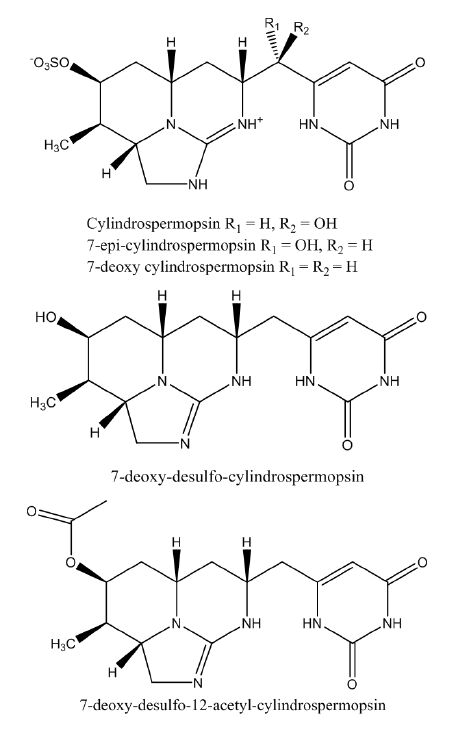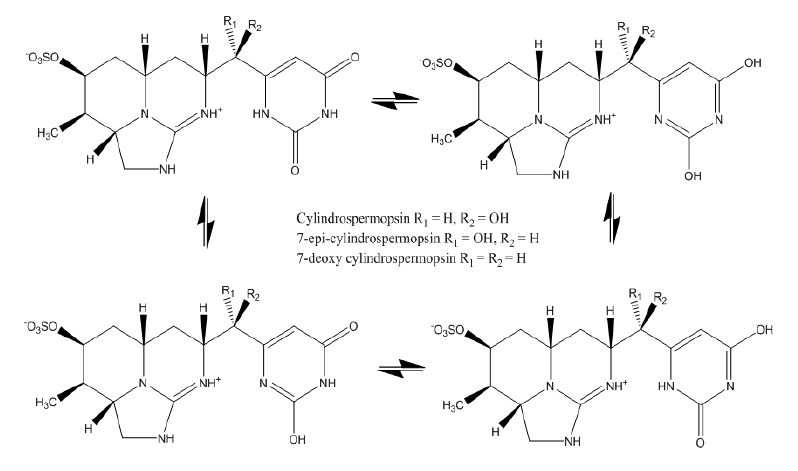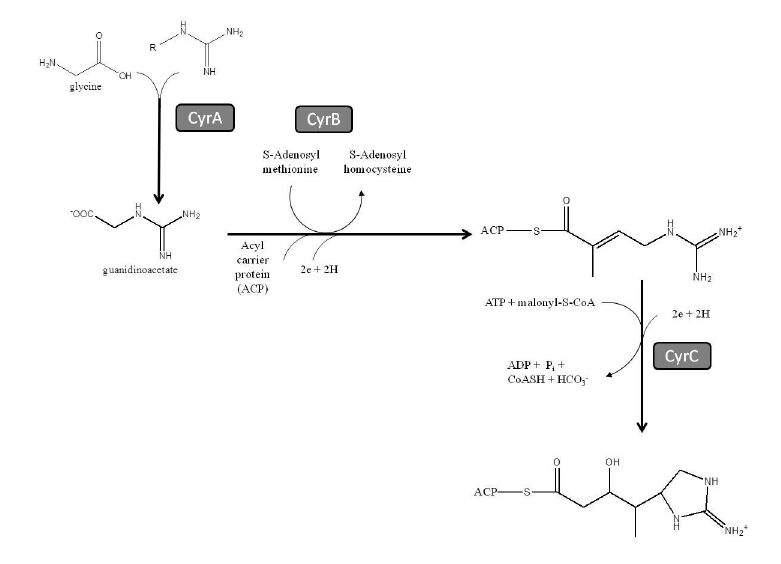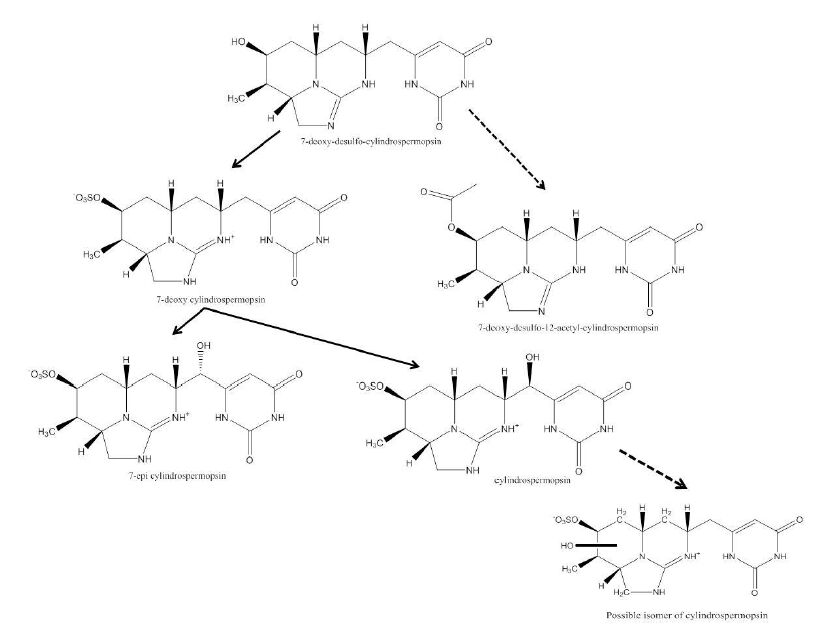The existence of a number of cylindrospermopsin analogs has been confirmed by several authors. These cylindrospermopsin analogs were formerly seen as minor constituents, with normal cylindrospermopsin always being the dominant form. However, it is now clear that the cylindrospermopsin analogs are the major species produced by certain organisms, the production being enhanced, at least in some cases, under specific physiological conditions. Presently, relatively little information is available concerning the properties, physiology of occurrence and toxicity of these molecules. The existing literature pertaining to these aspects is reviewed with respect to known cylindrospermopsin analogs.
The biosynthesis of the cylindrospermopsins is discussed and the previously established pathway has been modified to take account of the production of the known cylindrospermopsin forms. The anomalies in terms of in-vivo toxicity of 7-deoxy-cylindrospermopsin are reported, along with further attempts to rationalize the situation. We also discuss reasons for the apparently similar toxicity of 7-deoxy-cylindrospermopsin and cylindrospermopsin to cell cultures in vitro. It is hypothesized that the similarity of cylindrospermopsin intoxication to nonalcoholic fatty liver disease may argue for these cyanotoxins to exert their effects via a lysosomal pathway.
1.
Introduction
1.1. The urban landscape, the Anthropocene and the conflict
In this contribution1, we aim to focus on the transformed relationship between Covid-19 pandemic and urban spaces. Generally, it wants to reflect critically on the new environmental dynamics underlying urban landscapes in the Anthropocene era, where spaces and communities are read together within the dynamics of production-consumption and their effects on the global ecosystem [1]. These dynamics, to think of them with Bruno Latour [2], are outlined as real elements of a conflict between human and non-human agencies that face each other in the construction of reality.
1 Messina is the author of paragraphs 1, 2, 3.1 and 4. Nicosia is the author of paragraph 3.2.
Back in 1965, Kevin Lynch [3], had prophetically identified a critical juncture on the interconnections between city, environment and life prospects but, within the geographic discourse, the contemporary city looms as the spatial horizon in which the issue of sustainability takes on absolute importance. The city not only becomes an endless labyrinth engulfing the surrounding rural space [4], but it becomes a device of interaction and global clash of capitalist and consumer society [5]. Today's cities are the strong expression of the Anthropocene: they are spatially widespread, energy-intensive and inhabited by a multi-ethnic community. They are a global phenomenon in at least two aspects. In the literal sense, because statistics show that for several decades now more than half of the world's population has lived in cities; cities are global because they constitute a well-articulated ecosystem that draws meaning from the dynamic relationships established between the territorial components, local and global relations. It is no coincidence that global cities [6] are the hubs of capitalist globalization's network. On an international scale, the major metropolises operate more and more on synergy as a single network interconnected by flows of decisions, relationships, information, funds, new technologies, cultural and ideological influences.
In this sense, the essence of the city is conflicting. Giambattista Vico [7] already imagined an etymologically non-existent proximity between polemos (conflict) and polis (city). The urban dimension can be considered as the theatre of some great tensions that cross the deep structures of contemporaneity: human capital [8], economic-financial capital [9], production and consumption [10], the housing issue [11], the environmental issue [12] and inequalities [13]. In short, the city is a figure of socio-spatial complexity [14].
The pre-pandemic city, due to the enormous acceleration of mobility factors that involved all elements of urban reality, has undergone a break by experiencing lockdowns. The pandemic city has greatly changed its socio-cultural features in line with the transformative needs of a population endowed with identity and capacity for multiple actions on the territory. The city continues to be a very complex artifact that, as Maurizio Carta [15] states: "is never the product of a single deterministic will that produces individual actions, but is the result of arising sudden innovations, of independent dynamics at the beginning, but then interrelated by the creativity of the inhabitants, of actions set in motion by a very large number of individual and collective actors, each of which in pursuing its own ends finds itself adapting them within a system of reciprocal interrelations, the outcome of which always exceeds the intentions to the control of the most powerful actors2".
2 Italian text: "[La città] non è mai il prodotto di una unica volontà deterministica che produce azioni singole, ma è il risultato dell'emergere di innovazioni improvvise, di dinamiche indipendenti all'inizio, ma poi interrelate dalla creatività degli abitanti, di azioni messe in moto da un numero molto grande di attori individuali e collettivi, ciascuno dei quali nel perseguire i propri fini si ritrova a adattarli entro un sistema di interrelazioni reciproche, il cui esito supera sempre le intenzioni al controllo degli attori più potenti".
1.2. The cities of the "Postcovidcene"
While cities, more exposed to the dynamics of the Anthropocene, have been the most affected by the evolution of the pandemic, they have proven to be the most ready to implement resilient action [16]: think, for example, of the main Italian vaccination centers set up in exhibition spaces [17], which, through the very rapid transformation of their original functions, have made it possible to set up a massive vaccination campaign with human, material and logistics resources all gathered in one and the same spatiality.
The crisis from Covid-19 has facilitated analyses and studies of experts who have agreed to envisage the advent of a new world after the end of the pandemic, to address the difficulties caused by the ongoing process of slowbalization [18] and global warming since, after the health emergency, the war economy experienced to overcome it will provoke profound changes in the international geopolitical order as we have known it until today [19,20,21,22,23,24]. The Covid-19 pandemic, in addition to further depressing foreign trade and direct investment, has made clear the limits of a spatial organization of production characterized by an excessive interdependence of companies and economies, as shown by the interruption of entire production chains or the lack of individual protective equipment and medical instruments during the first phase of the health emergency [25,26].
In addition, due to the pandemic, even at the urban level the configuration of space/time/information/territory relationships [4] has been reshaped [27]. The management of the new paradigm of the post-pandemic city must then tend towards the enhancement and optimization of resources aimed at increasing the efficiency of the complex urban system. For this reason, many cities have tried to pursue the criterion of energy efficiency in order to be able to meet the current global strategic challenges. The adaptation to new needs, especially in large urban areas, more sensitive to the spread of Covid-19, involves complex models of management and adaptation and reuse interventions in which the city transforms itself rather than expanding. This transformation should aim at improving the quality of life, through new urban policies capable of adding value to the city, aimed equally at aesthetic, functional and social change [28].
Cultural and creative capital [29,30,31,32,33,34,35] need to mix to create an explosive mixture to be distributed in the everyday life of those peripheral communities that reside in areas that must abandon marginality and exclusion to become the centrality of an urban fabric remodeling spaces and economies. In this sense creativity can be considered a necessity, especially for those cities that do not have elements of established cultural attractiveness. Therefore, the creativity of a city seems to be guaranteed by the presence of a plurality of productive spaces promoting a continuous regeneration of the city itself making it, unlike the cultural capitals, a cosmopolitan environment linked to the dynamism of geographical and social spaces. The Covid-19 pandemic has led to new emergencies in urban and regional systems, highlighting the gap between centers and suburbs, but also the vulnerability of densely populated systems and the possibility of redesigning in a more balanced perspective, thanks to technologies, not only living, but also working, economic activities, creative abilities, cultural dynamism [36]. For cities, in short, to effectively trigger the exaptation [37] processes of the "Postcovidcene" represents a future that can no longer be postponed. Only cities have the autopoietic power [4] to ensure that creativity, collaboration, resilience and circular economy can help transform them into driving centers of social innovation, of sharing, of plurality, in a new context generated by the sustainable interaction between the green environment and its inhabitants [38,39,40].
2.
Goals and methods
This contribution, as explained in the introductory paragraphs, is intended to link the perspective of reflection on the relationship between sustainability and urban spaces. From a theoretical point of view, cities have been represented as autopoietic spaces that fully embody the criticalities and dynamics of the Anthropocene and, as a consequence, that possess endogenous energies for regeneration. In this sense, Covid-19 broke into history and catalyzed the reflections and strategies of urban regeneration. Having clarified these aspects, the contribution, through critical reading of the bibliography and analysis of official documents3, intends to focus critically on the impact that the EU Recovery Plan has on the dynamics of urban regeneration and sustainability and address. As a case study, we focus on the transformative dynamics of the city of Amsterdam, already initiated before the pandemic. The final paragraph contains the summary conclusions.
3 "Document analysis is a systematic procedure for reviewing or evaluating documents—both printed and electronic (computer-based and Internet-transmitted) material. Like other analytical methods in qualitative research, document analysis requires that data be examined and interpreted in order to elicit meaning, gain understanding and develop empirical knowledge" [41].
3.
Discussion
3.1. Cities and EU Next generation
The European Commission, the European Parliament and EU leaders, have agreed on a recovery plan that will help the European Union to repair the economic and social damage caused by the coronavirus health emergency and help lay the foundations for making the economies and societies of European countries more sustainable, resilient and prepared for the challenges and opportunities of the ecological and digital transition: an investment in the future of Europe and the Member States to restart after the Covid-19 emergency. With the start of the 2021–2027 programming period and the targeted strengthening of the EU's long-term budget, the focus is on the new cohesion policy and the financial instrument called NextGenerationEU, a temporary €750 billion instrument designed to stimulate a "sustainable, uniform, inclusive and fair recovery", aimed at ensuring the ability to cope with unforeseen needs, the largest package to stimulate the economy ever funded by the EU [42].
The management of funds dedicated in particular to Ecological Transition and Urban Regeneration constitutes a critical Hub for European Public Governance Strategies. As indeed Clarified by the ninth CIDOB Report [43] "The unprecedented funding of €672.5 billion from the Recovery and Resilience Fund (RRF), the main instrument of the Next Generation EU, is a unique opportunity for the best, green and digital, recovery from the COVID-19 pandemic. Cities are the arena where the success of these recovery measures will be decided. With 75% of European citizens living in cities and sub-national governments implementing 70% of EU legislation, Addressing the transformations that European institutions propose without considering the public policies implemented by city governments and efficient multi-level governance mechanisms is a major challenge. Cities across Europe are introducing innovations to stimulate energy efficiency in buildings and the use of clean technologies and renewable sources; to promote sustainable transport; to accelerate digitization processes while improving access to broadband services. They are the best guarantee of ensuring only transitions and that no one—and no territory—is left behind".
The issue of project and funding management then becomes crucial. In this sense, a certain centralization of Processes is denounced by several parties to the detriment of bottom-up or place-based approaches. In particular, the Committee of the Regions, through Rob Jonkman, CoR rapporteur on the implementation of the RRF, publicly denounced the risk of keeping the urban and local dimension out of decision-making processes [44]: "As the European Committee of the Regions has reiterated on recent occasions, local and regional authorities have important legal competences in many Member States across the six pillars of the RRF, especially the implementation of the green transitions, and digital transformation to economic and territorial cohesion and competitiveness. Take for example, climate adaptation works, major infrastructure projects towards sustainable urban mobility and green public procurement all affect local and regional authorities' plans. Cities and regions' involvement in the further implementation of this time-limited, once in a generation Recovery Plan is therefore not only a matter of logic and fairness, but also necessary for the RRF to truly achieve its stated objectives and avoid an absorption problem. As such, local and regional authorities should be recognized and treated as partners, not so-called "stakeholders", as the language of this Communication uses again. We need more partnership and multi-level cooperation and less centralization. Moreover, the financing potential that remains represents a good opportunity for member states which could access affordable loans. We call for the support of the European Parliament in particular, in ensuring more transparency and parliamentary control for the accessing of RRF funds by local and regional authorities".
The "Postcovidcene" challenge, especially in Europe, passes through cities.
3.2. The case of Amsterdam, the vanguard of sustainable regeneration
Cities are a crucial cornerstone of the UN strategy for sustainable development, Agenda 2030. In particular, SDG 11 "Sustainable cities and communities" aims at transforming urban centers into sustainable cities through access for the entire population to housing, basic services and adequate means of transport, cheap and safe, especially for the most vulnerable people. Furthermore, the cities of the future will have to be green, an objective that can be achieved through the reduction of negative impacts on the environment, the enhancement of green areas and safe and inclusive public spaces, with specific attention paid to the urban suburbs. Finally, the preservation of the common artistic and cultural heritage must be guaranteed. The pandemic has strongly impacted the implementation of the global sustainable development strategy [45,46,47] even in cities that, as mentioned, constitute the major areas of the challenge for sustainable transition [48].
There are already best practices in urban regeneration policies that signal a certain maturity in the environment by communities. To operate proactively, we need to go beyond the econometric standards of the last century and adopt a model of circular urban development as applied in Amsterdam as part of the Circular Strategy 2020–2025 [49,50], which we will address.
Cities in Northern Europe have long been committed to sustainability, a low-impact economy, high quality of life and the liveability of urban spaces [51]. Since 2007, Amsterdam has occupied the top positions in the Smart City ranking drawn up by the University of Vienna. Boyd Cohen then developed the Smart Cities Wheel, a ranking that considers all the fundamental components of what makes a city smart (smart people, economy, mobility, environment, governance, living). The process of smart transformation of the Metropolitan Region of Amsterdam started already in 2009 and is an excellent example of an initiative organized and financed both by public and private institutions, which aims to improve the quality of urban life while respecting environmental sustainability [52,53,54].
Together with private companies and groups, the city of Amsterdam is committed to supporting and developing the Amsterdam Smart City (ASC) program. The ASC model is simple: the 4 founding partners are the center, they have long-term economic interests and collaborate with other strategic partners such as Cisco, IBM, Philips and Accenture and other small and medium-sized companies. ASC is a plan of collaboration between inhabitants, government bodies and local production authorities, with the aim of implementing a high level of energy savings. Energy efficiency, use of renewable energy, recharges for electric vehicles and smart grids are some of the elements that will help to achieve important goals, such as reducing 40% of CO2 emissions by 2025 and 75% by 2040. The plan is divided into several projects concerning energy, mobility, quality of life (health, safety and tourism), efficient use of resources, intelligent infrastructure and open data. The transformation of Amsterdam into the first energy-saving European urban center began in June 2009, when the public space of Utrechtsestraat, the central street of the city center, became a sustainable shopping street. Local entrepreneurs have invested in a project that has contributed to the construction of bus stops made of recycled material, LED street lighting powered by solar panels placed on the roof of the stops and bins-compactors for the separate collection of garbage operating on solar energy. The success of the ASC project is given by the definition of a strategic plan, articulated in fundamental progressive stages for the implementation of the single interventions that have transformed the districts of Niew-West, Zuidoost and Ijburg (Figure 1) in laboratories.
In Niew-West, there is a high penetration of smart meters and photovoltaic installations thanks to subsidies that encourage residents to build roofs and green walls on their properties. The district was chosen for the first smart grid project in the Netherlands. In this way, the number of smart meters and monitoring and control devices is increased, reducing the number and duration of inefficiencies and increasing sustainable energy production. In April 2016, the City-zen project started, involving 23 partners for 30 million investments for Citizen empowerment, with particular attention to: Smart grids, Solar energy & storage, Renovation (52,000 m2), Flexible Public Lighting, Grinder and Serious Gaming. In the Zuidoost district, on the other hand, energy conversion works have been carried out on public buildings. These include the energy conversion of the Amsterdam stadium with the addition of 4,200 solar panels covering an area of 7,000 square meters. In addition, the Amsterdam Hospital, AMC Medical Centre, develops a viable business case for 35000 m2 solar PV on the roof. The port area of Ijburg is very frequented by tourists and therefore it was necessary to facilitate their stay with a good wireless network and a mobile wi-fi connection. This project was carried out by the municipality in collaboration with private entrepreneurs, the Amsterdam Smart City and KPN who saw an opportunity to combine wi-fi antenna, optical fiber and connector to meet the growing demand for mobile broadband in the port area of Ijburg.
In a smart city, the energy issue is very relevant. The inefficient use of energy from fossil sources impacts the environment and the phenomenon is accentuated precisely in cities where the concentration of population, buildings and plants is greater. The negative environmental effects due to an incorrect use of energy are not only present in the winter months but also in the summer months. A smart city is a city that addresses the energy issue in a global way and is a city that is committed to solving the energy issue all year round, promoting concrete actions.
The production of alternative energy plays a strategic role in the ASC project as demonstrated by the production of electricity from waste: 560 GWh per year and 548,000 GJ of residual heat that each year supply the operation of the tram, metro and public lighting. In addition, excess heat is used for district heating and to provide hot water to households and businesses reducing the need for fossil fuel for boilers. The most significant intervention of the ASC Project was the implementation of the smart grid that allows monitoring systems (energy boxes) to be installed in homes, to manage energy efficiently by optimizing consumption. The project started in 2009 with the installation in the buildings of the Zuidas district, one of the most productive in Amsterdam, of 3,000 photovoltaic solar panels. So, groups of citizens gathered in green cooperatives to propose alternative solutions to personally manage the energy market.
More than a third of Amsterdam's CO2 emissions come from the 400,000 homes in Amsterdam. To reduce these emissions, the Wesy Orange Project has been created, based on the use of intelligent technologies that save more than 10% of the energy consumed in homes. The aim of the project is to expand the utilities served by smart meters and connect up to 200,000 homes. Sustainable mobility can be defined as a set of actions that contribute to reducing negative environmental, social and economic impacts. Smart mobility starts from another assumption: the citizen must be able to see the convenience of using his car as little as possible. In Amsterdam, local administrators decided to launch a program to eliminate the use of internal combustion engines for road mobility within 30 years. The Councilor for the Environment, Marijke Vos, has launched a project that provides for 200,000 electric vehicles in circulation by 2040. To date there are about 10,000 electric vehicles circulating in Amsterdam thanks to the introduction of public incentives for their purchase. The city also offers an effective system of bike paths and a capillary bike sharing service (Mac Bike) with storage stations and a bike rental service. There are more than 70,000 bikers in Amsterdam.
Finally, since one third of the total CO2 emissions come from the transport system, in particular the maritime one, the "Ship to Grid" project has been started to install along the banks of the river Ij, 73 energy distribution columns produced from renewable sources with a total of 300 connections. These clean energy dispensers will allow boats to switch off their generators as soon as they moor and reduce CO2 emissions in the city.
With over 1200 victims in the city of Amsterdam [56], Covid has marked, as repeatedly reported, a crucial challenge for the continuation and implementation of sustainable urban development strategies even where they had been well defined. In this sense, the investigation into the re-semanticization of public transport, understood as space, conducted in Amsterdam during the lockdowns by Monik Kokkola, Anna Nikolaeva and Marco te Brömmelstroet is of absolute importance [57]; after the shock of the pandemic, it is desirable that the strategy continue in its implementation.
4.
Conclusions
The frenetic mobility has characterized the era in which we live until the beginning of 2020, involving people, objects, assets, signs, languages, inscribed directly in the city and its components. In fact, these become more and more adaptable and re-combinable according to the needs of the flows, as they are redesigned with new heterogeneous practices of crossing and confinement, which question the dichotomous distinctions between urban/extra-urban and local/global. These new urban landscapes in motion solicit new empirical, analytical and theoretical lenses in light of the current post-pandemic phase. From the point of view of urban policies, COVID19 was a tragic turning point. Cities deserted by lockdowns have experienced in a profound way the necessity to rethink the paradigms of housing and consumption. The focus on sustainability, urban regeneration and energy transition has resulted in a gigantic EU relaunch plan in Europe, which, however, is experiencing many problems of harmonization between levels of governance. Yet, the challenge for sustainability must be stubbornly implemented. Some communities, as the example of Amsterdam shows, have implemented a long-term strategy. It is to be hoped that policy and funding will be able to support a transition that is undelayable at this point.
Use of AI tools declaration
The authors declare they have not used Artificial Intelligence (AI) tools in the creation of this article.
Conflict of interest
The authors declare no conflict of interest. Giovanni Messina is the Guest Editor for AIMS Geosciences and was not involved in the editorial review or the decision to publish this article.










 DownLoad:
DownLoad:







